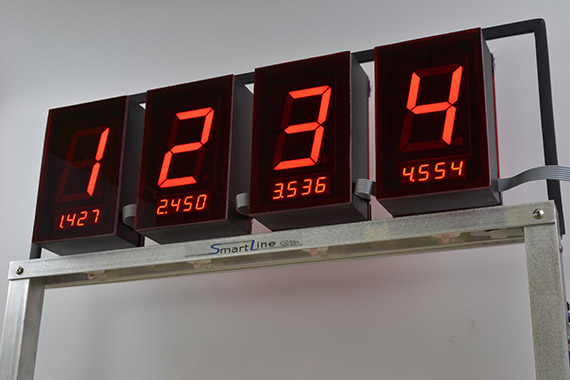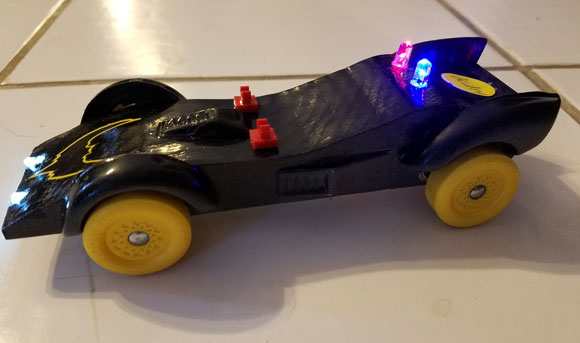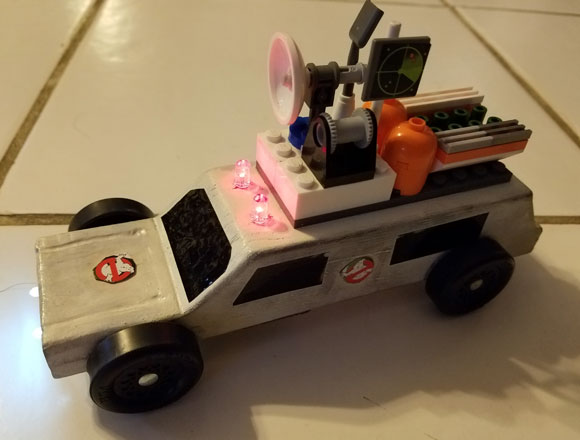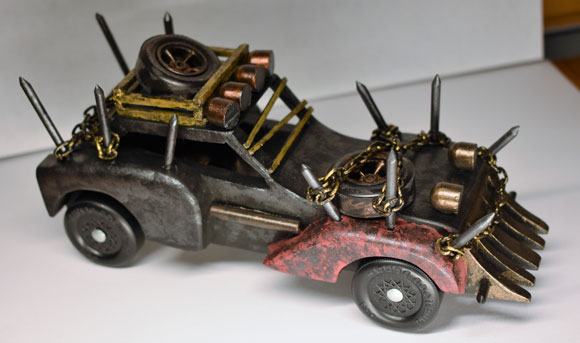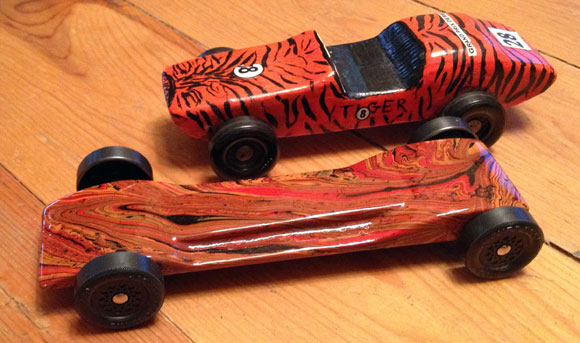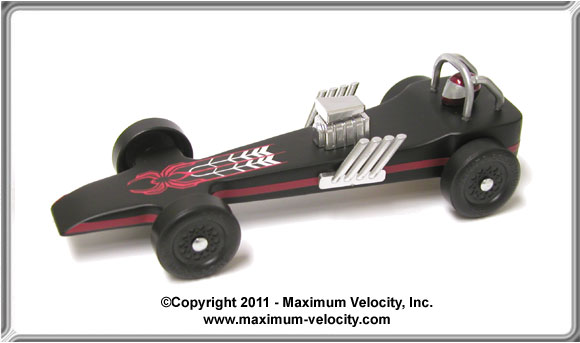PINEWOOD DERBY TIMES
Volume 17, Issue 2
October 11, 2017
In this Edition
– Editor’s Notes
– Feature Article – Timer Features and Comparisons
– Humor
– Product Showcase – Micro Tungsten Cylinders – 1 Cent
– Pinewood Derby Car Showcase
– Pinewood Derby Memory – Better Lucky than Good
– Q&A
Editor’s Notes
Ford Steam Races
In the fall of 2016, Ford began sponsoring pinewood derby races for Girl Scouts as part of their STEAM initiative (Science, Technology, Engineering, Arts, Mathematics). In 2017, Ford has expanded the race schedule and has announced eight events (one has already occurred). Likely, other events will be announced at a later time. You can find more information about this program and stay up to date on the race schedule Here.
We are clearing inventory on several items including:
– Velocinator and Formula One car kits
– Paint Stencils
Feature Article
Timer Features and Comparisons
By Randy Davis
Although a few groups still manually judge pinewood derby races, the vast majority of races are determined by electronic timers. Today’s timers are extremely accurate, are quite reliable, and readily interface to race management software. These capabilities help to make races run more smoothly and more quickly.
Just a quick Internet search will provide a list of many companies that offer pinewood derby electronics. Depending on the capabilities, prices range from $200 to over $600. Prices are driven by the number of lanes, the type of readout, and the feature list.
So before purchasing a timer, make sure you understand the different features that are available, and select those features that best suit your race situation. This article will first cover timer basics, followed by a discussion of the main timer features, and conclude with a list of companies and their offerings.
Timer Overview
Although there may be subtle differences, all timers consist of a set of light sensors which are normally mounted under the track at the finish line.(1) A light source is suspended over the track. This “bridge” generally has a light source for each lane, and it holds the electronic circuitry. A switch is mounted on the starting gate.When the gate is opened, the switch opens which signals the timer to start counting. When the first car passes between the sensor and the light source for its lane, the sensor signals to the timer to capture the time for that lane. The timer then displays 1st place for that car, optionally shows the time for that car, and continues monitoring the other lanes. When all the sensors have been triggered, the race is complete and, if there is a connected computer, the finish times are sent to the computer.
Timer Features
The main features to consider when purchasing timers are listed below. We will look at each one individually.
– Number of supported lanes
– Timer readout capabilities (what the audience sees on the timer)
– Timer accuracy
– Computer connectivity
– Track clearance
– Robustness and storage
One feature not mentioned is the “wow” factor. Some timers have aesthetic qualities that give a “wow” factor to your race. Other timers are more “bare bones”. Generally, you will pay more for a timer with a “wow factor”, but the extra price does not mean that the timer is necessary better.
Number of Supported LanesWhen a timer is purchased, the number of track lanes must be specified. The number of lanes is a decision that is made as part of the track purchasing decision.(2) Just like with the track, timers are not readily expandable to more lanes.(3)
Most timer companies support between 2 and 6 lanes. A few companies go to 8 lanes, while a few companies offer a single lane time (used for car testing).
Timer Readout CapabilitiesThere are four options for timer readout:
1. No readout – These timers send information directly to an attached computer and have no readout on the light bridge.
2. Flashing light results – Place order is shown by flashing lights. For example, solid on is for first place, fast flash is second, slow flash is third.
3. Numeric results – Place order is shown by numbers.
4. Numeric results and time – Place order is shown by numbers; elapsed time is also shown.
The type of readout has a direct correlation to cost. At the low end are timers with no readout. These timers still have a light source over the track, and sensors under the track. But the race information is just sent to a computer, and then displayed with a video projector. This is an inexpensive solution, but does have two drawbacks. First, the audience watches the race completion, and then must look at the video projection to see the results. Depending on where a person is seated, this may be fine, but could be an issue for a person with their back to the screen. A second issue is if there is any issue with computer communications, the timer is basically useless. With timers that show the results on the bridge, results can be manually entered into computer software if needed.
Figure 1: Timer with No Readout
Source: pinewood-derby-timer.com
Moving up, we get to timers with flashing lights to display the results. This works fine, but a numerical display is generally easier for the audience to understand, as no explanation of the meaning of the flashing lights is needed.
Figure 2: Timer with Flashing Lights
Source: microwizard.com
http://microwizard.com/images/k1small.gif
Next, we have timers which numerically display the race results. Large numerals make it easy for the audience to see the winner, and provide a sanity check for the race officials.
Figure 3 – Timer with Numeric Readout
Source: besttrack.com
If you are using a video projector to display results, then an elapsed time readout on the bridge is not really necessary as that information would be shown on the screen. However, it does add a “wow” factor.
Figure 4 – Timer with Numeric and Elapsed Time
Source: etekgadget.com
Note that some companies offer bridges with numeric and/or timer readout on both sides. Typically, the timer display is on the side of the bridge facing the starting gate. This allows visibility by the race staging officials, and by most of the audience. Some timer companies offer dual display, where the information is shown on both sides of the bridge. This option provides better visibility for the audience, and facilitates locating the computer at the end of the track. But it does add cost, so determine if you need dual visibilitybefore investing the money.
Timer ResolutionGenerally, pinewood derby heat times are shown to three decimal places (e.g. 2.565 seconds). However, many timer manufacturers advertise resolution to four decimal places or even more. A higher resolution tends to minimize ties, but there is a caveat.
On a typical track, a difference of .001 seconds equates to about 1/16 inch of car travel. But a .0001 difference equates to 1/160 of an inch (.006) of travel, a number that is virtually unmeasurable. When installing sensors under the track, the accuracy of hole alignment is very critical. For example, if a sensor is misaligned by .01 (less than 1/64 inch), then times beyond three decimal points are meaningless. But even if sensors are perfectly aligned, sensor occlusion becomes a factor when measuring to four decimal points.(4) Generally, sensors trip when they are 50 percent occluded (blocked). But if one sensor requires 60 percent blockage while the others require 50 percent blockage, then the fourth decimal point is meaningless. Finally, the size of the hole in the track is also a factor. A larger opening allows more light, leading to less accurate timing. Light reflectivity can cause sensors to not trip until the car is beyond the sensor. Best accuracy is attained with a small aperture (about 1/8 inch diameter) in the track.
So, while a high-resolution timer may seem important, in real life times of more than three decimal points are suspect.
Computer ConnectivityMost timers use a serial cable to connect between the timer and a computer. Since most modern computers no longer have a serial connector, the serial cable connector is attached to a Serial-to-USB converter, which then plugs into a USB port on the PC. The reason for using a serial cable is due to the USB distance limitation of five meters (16.4 feet – a serial cable can run 50 feet). If the PC were always located at the end of the track, then USB could be used. But in practice, many officials prefer to locate the computer near the starting line to provide easier communication between the officials staging the race and the computer operator. So, serial communication continues to be the method of choice, especially since Serial-to-USB converters are relatively inexpensive (around $30).
Figure 5 – Serial-to-USB Converter
Source: grandprix-software-central.com
Track ClearanceThe height of the bridge above the track determines the maximum height of cars that can be ran on the track. Most timers have plenty of clearance for any event, even including 18-wheeler races. However, some timers have a lower profile. So, make sure to know what clearance you need before investing in a timer. Then include the maximum height of cars in your race rules.
Robustness and StorageTimers are electronic equipment, and as such should be treated with due care. A dedicated box with proper padding should be used to store the timer between events. But during a race, mishaps do occur, so the timer needs to be rugged enough to handle typical issues such as:(5)
– Car derailing and smashing into the side post,
– Errant foot kicking the timer,
– Tripping on a cable causing the connector to torque the timer (make sure all cables are taped to the floor and out of the normal walking area),
– Dropped timer during installation or tear-down.
Timer Companies
Here is a list of companies that offer timers. I have left out “Do-it yourself” timer companies, and companies that make a timer only for their track. Note that the listing order below is random.
Micro Wizard – microwizard.com – Offers the FastTrack line of timers with flashing lights, numeric, or numeric/time readouts. Supports 2-6 lanes, dual display optional, 5.5 inch clearance, 0.0001 second internal resolution, external display of three decimal digits.
SmartLine – etekgadget.com – Offers SmartLine timers with numeric, or numeric/time readouts. Supports 1-8 lanes, dual display optional, 6-7 inch clearance, .00005 second internal resolution, external display of three decimal digits.
Newbold – pinewood-derby-timer.com – Offers the Turbo timer with numeric readouts. Supports 1-8 lanes, dual display optional, time readout on side module – not audience visible, clearance not specified, internal resolution not specified, external display of four decimal digits, optional USB computer connectivity. Also offers DerbyStick, a timer with no readout on the bridge.
DerbyMagic – derbymagic.com – Offers the DerbyMagic timer with numeric, or numeric/time readouts. Supports 1-6 lanes, dual display optional, clearance not specified, .0001 internal resolution, external display of three decimal digits, USB connection to computer.
New Directions – newdirections.ws – Offers the Judge timer with flashing light readouts. Supports 1-8 lanes, single sided display, optional time readout – not audience visible, 3 inch clearance, .00001 internal resolution, external display of five decimal digits, full sunlight option. Also offers Transponder, a timer with no readout on the bridge.
Conclusion
I hope this article is helpful to you, should you be in the timer market. There are a large number of options in the timer market, which can greatly affect the final cost. So, my council is to first decide what options are needed for your race, and then select a timer that meets those options.
(1) One exception is the Judge timer from New Directions. It has the light source (non-visible frequency) in the track and the sensors in the bridge. This eliminates light reflection issues.
(2) For more information on the track purchasing decision, please see Pinewood Derby Times Volume 16, Issue 8 – “Buying a New Track? Let’s Consider Some Factors”.
(3) Except for the Turbo timer from NewBold Products.
(4) For more information on timer accuracy in real life, please see Pinewood Derby Times Volume 7, Issue 2 – “Is Your Finish Line Providing Accurate Results?”
(5) All of these have happened at a race I have ran or attended.
Humor
A lion woke up one morning feeling really rowdy and mean.
He went out and cornered a small monkey, and roared, “Who is mightiest of all jungle animals?”
The trembling monkey says, “You are, mighty lion!”
Later, the lion confronts an ox and fiercely bellows, “Who is the mightiest of all jungle animals?”
The terrified ox stammers, “Oh great lion, you are the mightiest animal in the jungle!”
On a roll now, the lion swaggers up to an elephant and roars, “Who is mightiest of all jungle animals?”
Fast as lightning, the elephant snatches up the lion with his trunk, slams him against a tree half a dozen times leaving the lion feeling like it’d been run over by a safari wagon.
The elephant then stomps on the lion till it looks like a corn tortilla and rambles away.
The lion lets out a moan of pain, lifts his head weakly and hollers after the elephant, “Just because you don’t know the answer, you don’t have to get so upset about it!”
Product Showcase
Micro Tungsten Cylinders – 1 Cent
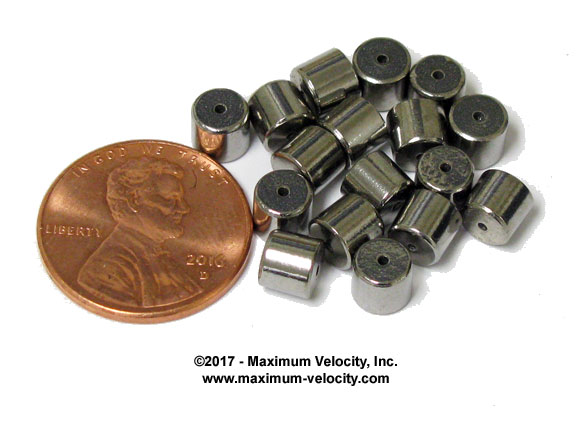
Each package contains one ounce of weight (17 cylinders). Each micro- cylinder measures:
0.209 OD (just under 13/64)
0.185 long (just under 3/16)
1.7 grams each
0.040 through hole (some of these are plugged up)
Micro Tungsten Cylinders are typically used as trim weighting for cars. They can be inserted individually into holes (drill 7/32), or can put poured into a larger hole or cavity. Secure with epoxy or hot glue.
Through October 31, 2017, you can get one ounce of Micro Tungsten Cylinders for 1 Cent. To take advantage of this limited time offer, add part 15046 to your shopping cart, and use coupon code OCT18NL during checkout.
Pinewood Derby Car Showcase
Batmobile and Ghostbusters – Charles Gaffron
My son won 2nd for best design at pack and district derby with his Batmobile. Other son’s Ghostbuster car won 1st for best design at pack and district!
Mad Max Road Fury – Logan and Sam Last
This car won first place for best design for the pack and district races. The car is completely hallowed out and a one dollar coin was used on the inside to add weight. Thank you so much!!
Old and New – David Keith
Forty-two years ago my father helped me make one of my first pinewood derby cars. It was an awesome experience which instilled in me the love of pinewood derby racing. For Father’s Day this year I took all my knowledge (mostly thanks to you) and built him one of the fastest cars I’ve ever built. He was so excited! Now, all of my adult children have a love for the Derby, and their kids are excited to make their own cars someday soon. This time honored tradition of car building and racing is transcending our four generations and has created great family memories for many! By the way, the paint job on the new car was created with a dipping method that I’ve been working on.
Share Your Car With Our Readers
Do you have a car you would like to “show off” to our readers? If so, send us a photo of your car along with a description of any special features to:
[email protected]
Please include your full name. If selected, we will include the photo and description in this newsletter.
Photos must be sent by e-mail in JPG format (minimum size of 640×480, maximum size of 1280 x 960). Please shoot photos from the front left of the car, similar to the orientation of this car:
For better focus, keep the camera four or five feet away from the car, and then use the camera’s zoom to fill the frame with the car. Also, use a solid (preferably white) background for the photo.
Send only one photo per car, unless an additional photo is needed to adequately show a feature. Also, only one car per subscriber per year please. Thanks.
Pinewood Derby Memory
Better Lucky than Good
This happened years ago when my son was still racing. He is an Eagle Scout now, and I am now enjoying pinewood derby racing with my grandson.
The second year my son raced his car, I had to work and was not able to be at the race. He had come in 3rd Place at the race the previous year, but came in 1st Place the second year. The top four finishers went to the district race.
Before the district race, we spent what seemed like hours polishing, lubing, aligning – everything we knew to do.
After the check-in at the district race, we were walking around looking at some of the other cars. One of the boys in our pack had a car that would not pass inspection. He had rounded the wheels. This was not caught at the pack race – I’m sure that he didn’t know that this was not allowed. I told him that we had brought another set of wheels, and if it was OK with the judges he was welcome to use them. We had not done anything to these wheels, not even removed the mold marks. The boy added some graphite, and then put them on the car.
Even though my son’s car had beaten him at the pack event, this boy placed 7th or 8th out of about 80 cars, well ahead of my son. That goes to show that it’s sometimes better to be lucky than good!
Kenny
Do you Remember?
If you have a pinewood derby story that is funny, unusual, sad, heart-warming, etc., please send it to me in an e-mail. Don’t worry about literary polish. We will edit as needed before publishing. If your story is used, you will receive a $10 coupon in May of 2017.
Q&A
Q: My son’s car qualified for Districts, but we’d like to tweak a bit more speed out of it. It is rail-riding but only getting ~196 MPH. The front dominant axle is bent at 2.5 degrees or so. Testing it on an Awana track yesterday the fastest times came when it was “fish-tailing” the whole way down. When “going straight” and not fish-tailing, the times were slower.
1) Do you think this is due to something on the car rubbing against the guide rail?
2) Do you think that canting the rear axles would help us?
3) If so, how do we make it go straight?
A: It is possible that when the car is going straight, the rear wheel on the dominant side is also riding the rail. This would slow down the car. Angling the rear axles should help this. here are some key points:
1. Make sure that the front dominant wheel is steering the car towards the raised wheel, so that the front dominant wheel rides the rail.
2. The front dominant axle needs to angle downwards (wheel rides on outer edge).
3. The drift needs to be a minimum of 5 inches over 8 feet. Oftentimes, people set the drift much too small. When a car fishtails, increase the drift to stop it.
4. The rear axles angle upwards (wheels ride on inner edge).
5. Make sure the rear wheels are properly aligned. For rear wheel alignment help and other rail-riding topics, please read the main article in this newsletter.
Q: We have had our bottle of Max-V-Lube for about five years. Is it still effective or does its effectiveness diminish over time? We have always kept the lid on.
A: As long as the cap was on the bottle it should fine. Graphite has an indefinite shelf life.
Want Answers?
Do you have a pinewood derby-related question? If so, e-mail us your question.We answer all questions by e-mail, but not every question will appear in the Q&A section of the newsletter.
Back Issues
Are you a new subscriber, or have you missed some of the previous newsletters? Don’t miss out; all of the issues for Volume 5 through Volume 17 are posted on our web site.
Newsletter Contributions
We welcome your contributions. If you would like to contribute an article, a web site review, a speed tip, or a pinewood derby memory, please e-mail us.
Subscription Information
The Pinewood Derby Times is a free e-newsletter focused on pinewood derby racing. It is published biweekly from October through March.
If you haven’t already done so, please forward this issue to your pinewood derby friends. But please don’t subscribe your friends. Let them decide for themselves. Thanks.
If this newsletter was forwarded to you, why not subscribe to receive this newsletter. There is no cost, and your e-mail address is safe, as we never sell or share our distribution list.
To subscribe, send a blank e-mail to
[email protected]
You will receive a confirmation e-mail. Reply to the confirmation e-mail and you will start receiving the Pinewood Derby Times with the next issue.
Randy Davis, Editor, Pinewood Derby Times
E-Mail: [email protected]
(C)2017, Maximum Velocity, Inc. All rights reserved. Please do not reprint or place this newsletter on your web site without explicit permission. However, if you like this newsletter we grant permission, and encourage you to e-mail it to a friend.
Maximum Velocity disclaims any personal loss or liability caused by utilization of any information presented in this newsletter.
The Pinewood Derby Times is not specific to, and is not affiliated with the Boy Scouts of America, YMCA, Awana, or any other organization.
(R)Maximum Velocity is a registered trademark of Maximum Velocity, Inc.
(R)Pinewood Derby is a registered trademarks of the Boys Scouts of America.
(R)Awana is a registered trademark of Awana Clubs International.
All other names are trademarks of their respective owners.



